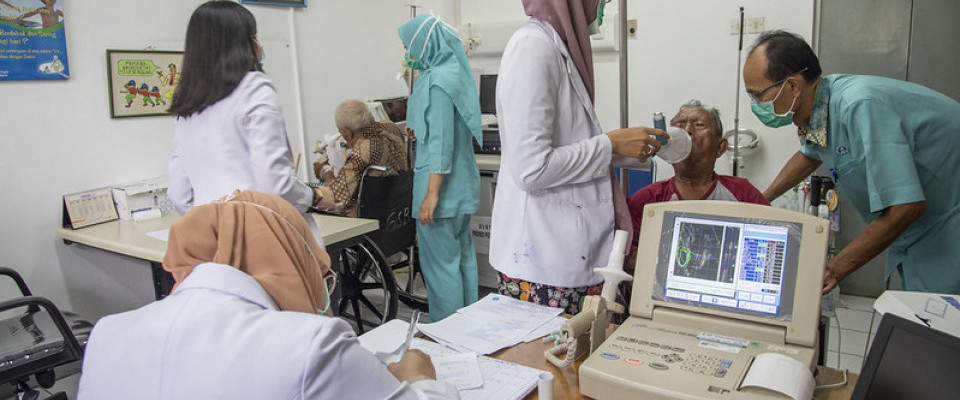
DKI Jakarta is a metropolitan capital city with a high population. With high economic growth, Jakartans are easily exposed to the impacts of this growth, one of which is environmental impacts such as air pollution which is harmful to human health.
In the last two decades, many studies have been conducted in Jakarta that has linked exposure to air pollution, especially to particulate matter (PM) measuring 2.5 microns or popularly known as PM2.5, as a source of various cardiovascular diseases and respiratory infections. In 2002, a study from the Asian Development Bank estimated that air pollution had an impact on more than 90 million cases of respiratory symptoms with an estimated economic loss of around IDR 1.8 trillion [1]. Similar studies were also conducted by Resosudarmo and Napitupulu which estimated that there were 3,000 deaths and 90 million cases of respiratory symptoms caused by air pollution exposure [2]. Six years later, the Ministry of Environment and Forestry reported that 57.8% of DKI Jakarta residents were affected by various cardiovascular diseases and respiratory infections due to exposure to air pollution [3].
How does air pollution enter our bodies?
This high number is not surprising because the microscopic nature and size of pollutants from air pollution can directly enter and penetrate the human body's defences, damage organs such as the lungs, heart, and brains, which in turn causes adverse effects, both acute and chronic. The level of damage or severity of health conditions caused by exposure to air pollution depends on the type of pollutant and the dose or concentration level of exposure. Of the various types of pollutants present in ambient air, there are two main pollutants that have the greatest detrimental impact on human health, namely surface ozone (O3) and PM2.5 (particulates less than 2.5 micrometres in diameter).
These pollutants can affect health throughout human life, from pregnancy to old age. In the short term, air pollution can cause health problems such as irritation of the eyes, nose, skin, throat, wheezing, coughing and chest tightness, and difficulty breathing, to more serious conditions, such as asthma, pneumonia, bronchitis, and other problems. lungs and heart. Some even experience direct effects such as headaches, nausea, and dizziness after exposure to air pollution [4]
For long-term effects, the health conditions caused are more chronic (such as cancer) and even cause death. The results of the Global Burden of Disease Study in 2019 showed an increased risk of death from long-term exposure to PM2.5 and ground-level ozone [5]. Not only mortality, but several other epidemiological studies have also found a correlation between exposure to air pollution and an increased risk of low birth weight, small for gestational age, premature birth, and stunting [5,6,7].
Jakarta is not the only one affected
Air pollution is estimated to cause at least 50% of morbidity in Indonesia [8]. In addition, for patients with COPD (chronic obstructive pulmonary disease) who are not smokers, exposure to outdoor and indoor air pollution is one of the main causes of the disease [9]. Meanwhile, in 2015, forest fires in Sumatra caused an increase in cases of respiratory symptoms and decreased lung function [10].
If not controlled and monitored more closely, increasing air pollution will be very difficult to avoid. Seeing the magnitude of the impact of air pollution on health, the process of controlling and monitoring air pollution should be carried out in a sustainable manner. In addition, cooperation in the fields of research, public policy development, air pollution monitoring, and politics is essential for effective air pollution control.
References:
- S. Syahril, B. P. Resosudarmo, and H. S. Tomo, “Study on air quality in Jakarta, Indonesia: future trends, health impacts, economic value and policy options,” ADB, Jakarta, 2002.
- B. P. Resosudarmo and L. Napitupulu, “Health and Economic Impact of Air Pollution in Jakarta,” Economic Record, vol. 80, no. s1, pp. S65–S75, Sep. 2004, doi: https://doi.org/10.1111/j.1475-4932.2004.00184.x.
- A. Safrudin et al., Cost Benefit Analysis for Fuel Quality and Fuel Economy Initiative in Indonesia. 2013.
- I. Manisalidis, E. Stavropoulou, A. Stavropoulos, and E. Bezirtzoglou, “Environmental and Health Impacts of Air Pollution: A Review,” Frontiers in Public Health, vol. 8. Frontiers Media S.A., Feb. 20, 2020. doi: 10.3389/fpubh.2020.00014.
- C. Abbafati et al., “Global burden of 87 risk factors in 204 countries and territories, 1990–2019: a systematic analysis for the Global Burden of Disease Study 2019,” The Lancet, vol. 396, no. 10258, pp. 1223–1249, Oct. 2020, doi: 10.1016/S0140-6736(20)30752-2.
- V. C. Pun, R. Dowling, and S. Mehta, “Ambient and household air pollution on early-life determinants of stunting—a systematic review and meta-analysis,” Environmental Science and Pollution Research, vol. 28, no. 21, pp. 26404–26412, 2021, doi: 10.1007/s11356-021-13719-7.
- Y. Liu, J. Xu, D. Chen, P. Sun, and X. Ma, “The association between air pollution and preterm birth and low birth weight in Guangdong, China,” BMC Public Health, vol. 19, no. 1, p. 3, 2019, doi: 10.1186/s12889-018-6307-7.
- B. Haryanto, “Climate Change and Urban Air Pollution Health Impacts in Indonesia,” in Climate Change and Air Pollution: The Impact on Human Health in Developed and Developing Countries, R. Akhtar and C. Palagiano, Eds. Cham: Springer International Publishing, 2018, pp. 215–239. doi: 10.1007/978-3-319-61346-8_14.
- N. Nguyen Viet et al., “The prevalence and patient characteristics of chronic obstructive pulmonary disease in non-smokers in Vietnam and Indonesia: An observational survey,” Respirology, vol. 20, no. 4, pp. 602–611, May 2015, doi: https://doi.org/10.1111/resp.12507.
- J. Zaini, A. Susanto, E. Samoedro, V. Bionika, and B. Antariksa, “Health consequences of thick forest fire smoke to healthy residents in Riau, Indonesia: a cross-sectional study,” Medical Journal of Indonesia, vol. 29, pp. 58–63, Mar. 2020, doi: 10.13181/mji.oa.204321.
Related tags: